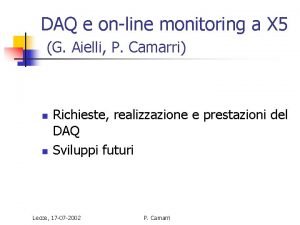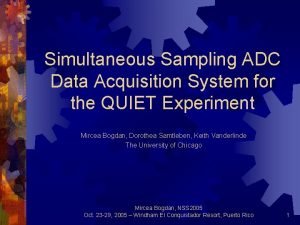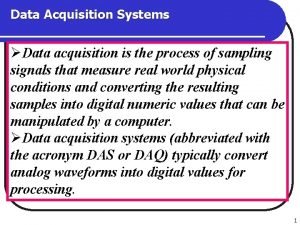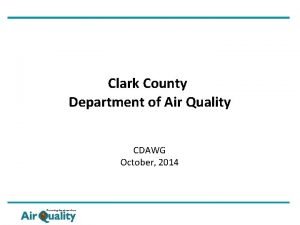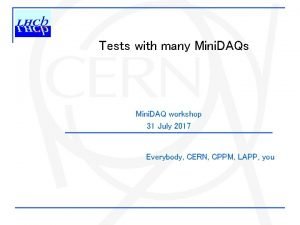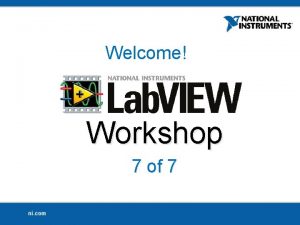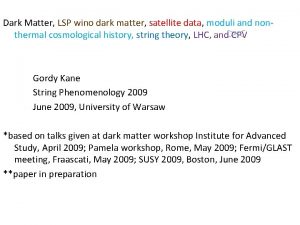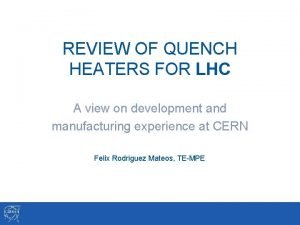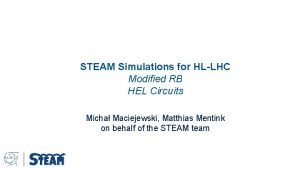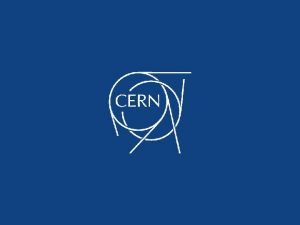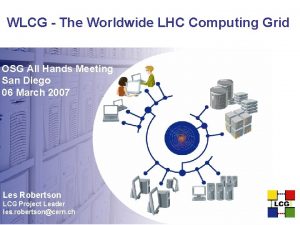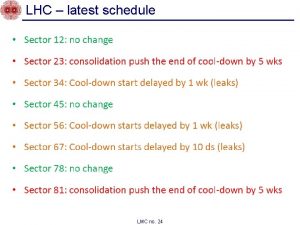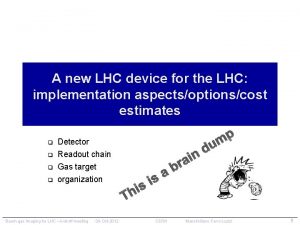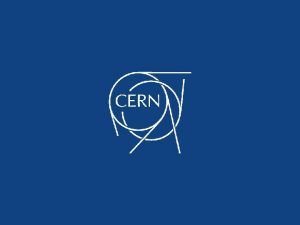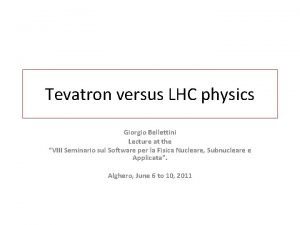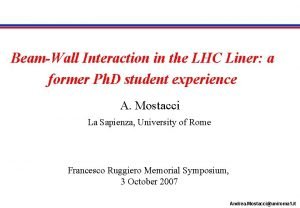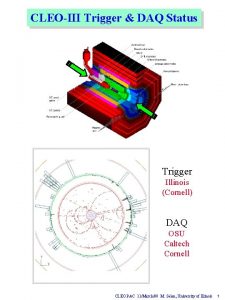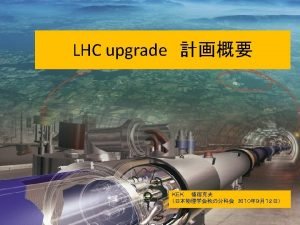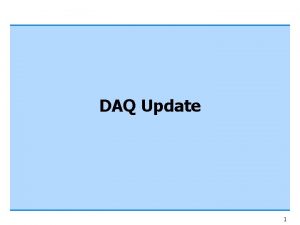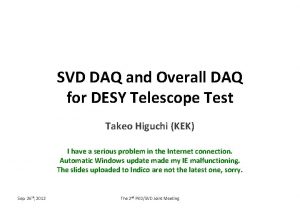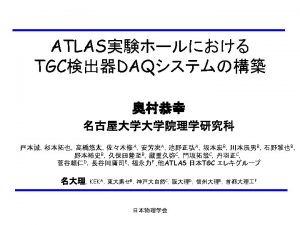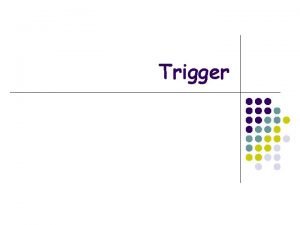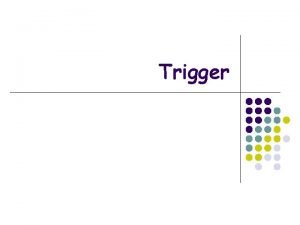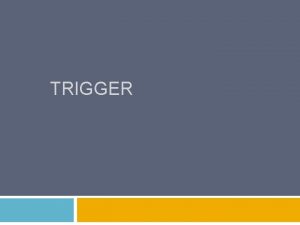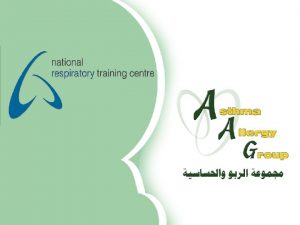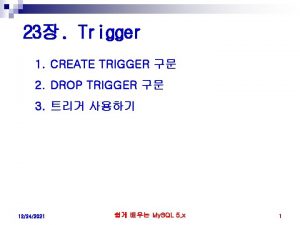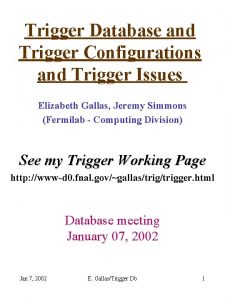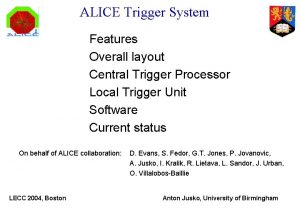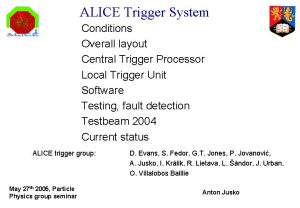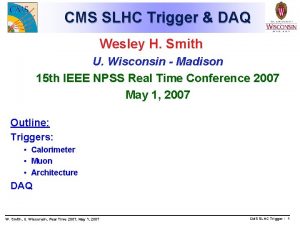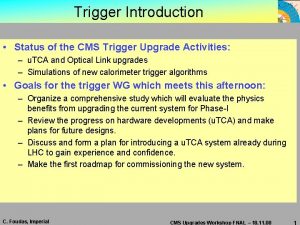CMS Trig DAQ for LHC Overall Trigger DAQ



















- Slides: 19

CMS Trig & DAQ for LHC Overall Trigger & DAQ Architecture: 2 Levels: Level-1 Trigger: Interaction rate: 1 GHz Bunch Crossing rate: 40 MHz Level 1 Output: 100 k. Hz (50 initial) Output to Storage: 100 Hz Average Event Size: 1 MB Data production 1 TB/day W. Smith, U. Wisconsin, CMS SLHC EMU Upgrade Workshop, Jan. 8, 2008 Introduction to CMS SLHC Triggers - 1

SLHC Level-1 Trigger @ 1035 Occupancy • Degraded performance of algorithms • Electrons: reduced rejection at fixed efficiency from isolation • Muons: increased background rates from accidental coincidences • Larger event size to be read out • New Tracker: higher channel count & occupancy large factor • Reduces the max level-1 rate for fixed bandwidth readout. Trigger Rates • Try to hold max L 1 rate at 100 k. Hz by increasing readout bandwidth • Avoid rebuilding front end electronics/readouts where possible • Limits: readout time (< 10 µs) and data size (total now 1 MB) • Use buffers for increased latency for processing, not post-L 1 A • May need to increase L 1 rate even with all improvements • Greater burden on DAQ • Implies raising ET thresholds on electrons, photons, muons, jets and use of multi-object triggers, unless we have new information Tracker at L 1 • Need to compensate for larger interaction rate & degradation in algorithm performance due to occupancy Radiation damage -- Increases for part of level-1 trigger located on detector W. Smith, U. Wisconsin, CMS SLHC EMU Upgrade Workshop, Jan. 8, 2008 Introduction to CMS SLHC Triggers - 2

Tracking needed for L 1 trigger L = 1034 Single electron trigger rate Isolation criteria are insufficient to reduce rate at L = 1035 cm-2. s-1 Muon L 1 trigger rate L = 2 x 1033 5 k. Hz @ 1035 Cone 10 o-30 o Amount of energy carried by tracks around tau/jet direction (PU=100) We need to get another x 200 (x 20) reduction for single (double) tau rate! W. Smith, U. Wisconsin, CMS SLHC EMU Upgrade Workshop, Jan. 8, 2008 MHz ~d. ET/dcosq Standalone Muon trigger resolution insufficient Introduction to CMS SLHC Triggers - 3

CMS ideas for trigger-capable tracker modules -- very preliminary • Use close spaced stacked pixel layers • Geometrical p. T cut on data (e. g. ~ Ge. V): • Angle ( ) of track bisecting sensor layers defines p. T ( window) • For a stacked system (sepn. ~1 mm), this is ~1 pixel • Use simple coincidence in stacked sensor pair to find tracklets • More details & implementation next slides Mean p. T distribution for charged particles at SLHC cut here -- C. Foudas & J. Jones A track like this wouldn’t trigger: <5 mm Search Window W. Smith, U. Wisconsin, CMS SLHC EMU Upgrade Workshop, Jan. 8, 2008 w=1 cm ; l=2 cm r. L y r. B x Introduction to CMS SLHC Triggers - 4

p. T Cuts in a Stacked Tracker – p. T Cut Probabilities • Depends on: - J. Jones Layer Sepn. & Radius Pixel Size Search Window 20 micron pitch r=10 cm Nearest-neighbor There is an additional ‘blurring’ caused by charge sharing… W. Smith, U. Wisconsin, CMS SLHC EMU Upgrade Workshop, Jan. 8, 2008 Introduction to CMS SLHC Triggers - 5

Alternative Tracking Trigger: Associative Memories (from CDF SVX) Challenge: input Bandwidth divide the detector in thin sectors. Each AM searches in a small Data links OFF DETECTOR 1 AM for each enough-small Patterns Hits: position+time stamp All patterns inside a single chip N chips for N overlapping events identified by the time stamp -- F. Palla, A. Annovi, et al. Event 1 Event 2 Event 3 AMchip 1 AMchip 2 AMchip 3 W. Smith, U. Wisconsin, CMS SLHC EMU Upgrade Workshop, Jan. 8, 2008 Event. N AMchip. N Introduction to CMS SLHC Triggers - 6

Cluster width discrimination -- F. Palla MIP 90 cm 70 cm 50 cm 30 cm In the region above 50 cm, using 50µm pitch, about 5% of the total particles leave cluster sizes with ≤ 2 strips Discrimination of low p. T tracks made directly on the strip detector by choosing suitable pitch values in the usual range for strip sensors. (Needed because 25 M channels x 4% occupancy would require 6000 2. 8 Gbps links at 100 k. Hz. ) W. Smith, U. Wisconsin, CMS SLHC EMU Upgrade Workshop, Jan. 8, 2008 • No. of links (2. 5 Gbps) ~300 for whole tracker (assuming 95% hit rejection) Once reduced to ~100 KHz, it would only need few fast readout links to readout the entire Tracker Introduction to CMS SLHC Triggers - 7

CMS SLHC e / / object track correlation Use e / / objects to seed tracker readout • Track seed granularity 0. 087 x 0. 087 1 x 1 • Track seed count limited by presorting candidates • e. g. , Maximum of 32 objects? Tracker correlation • Single track match in 3 x 3 with crude PT (8 -bit ~ 1 Ge. V) • Electron (same for muons) • Veto of high momentum tracks in 3 x 3 • Photon • Single or triple track match • Tau W. Smith, U. Wisconsin, CMS SLHC EMU Upgrade Workshop, Jan. 8, 2008 Introduction to CMS SLHC Triggers - 8

Tracking for electron trigger Present CMS electron HLT - C. Foudas & C. Seez Factor of 10 rate reduction : only tracker handle: isolation • Need knowledge of vertex location to avoid loss of efficiency W. Smith, U. Wisconsin, CMS SLHC EMU Upgrade Workshop, Jan. 8, 2008 Introduction to CMS SLHC Triggers - 9

Tracking for -jet isolation -lepton trigger: isolation from pixel tracks outside signal cone & inside isolation cone Factor of 10 reduction W. Smith, U. Wisconsin, CMS SLHC EMU Upgrade Workshop, Jan. 8, 2008 Introduction to CMS SLHC Triggers - 10

L 1 Tracking Trigger for Muons Combine with L 1 trigger as is now done at HLT: • Attach tracker hits to improve PT assignment precision from 15% standalone muon measurement to 1. 5% with the tracker • Improves sign determination & provides vertex constraints • Find pixel tracks within cone around muon track and compute sum PT as an isolation criterion • Less sensitive to pile-up than calorimetric information if primary vertex of hard-scattering can be determined (~100 vertices total at SLHC!) To do this requires information on muons finer than the current 0. 05 2. 5° • No problem, since both are already available at 0. 0125 and 0. 015° W. Smith, U. Wisconsin, CMS SLHC EMU Upgrade Workshop, Jan. 8, 2008 Introduction to CMS SLHC Triggers - 11

Muon Trigger Rate Estimate of L 1 Trigger rate vs. p. T • Assume very simple Tracker Trigger finding algorithm • No isolation required • Correlate with estimated L 1 -Muon alone ry a n i m li e r P W. Smith, U. Wisconsin, CMS SLHC EMU Upgrade Workshop, Jan. 8, 2008 Introduction to CMS SLHC Triggers - 12

CMS L 1 Algorithm Stages Current for LHC: TPG RCT GT Proposed for SLHC (with tracking added): TPG Clustering Correlator Selector Trigger Primitives e / clustering 2 x 2, -strip ‘TPG’ Jet Clustering µ track finder DT, CSC / RPC Missing ET Tracker L 1 Front End Regional Track Generator Seeded Track Readout Regional Correlation, Selection, Sorting Global Trigger, Event Selection Manager W. Smith, U. Wisconsin, CMS SLHC EMU Upgrade Workshop, Jan. 8, 2008 Introduction to CMS SLHC Triggers - 13

CMS SLHC Trigger Architecture LHC: • Level 1: Regional to Global Component to Global SLHC Proposal: • Combine Level-1 Trigger data between tracking, calorimeter & muon at Regional Level at finer granularity • Option to “seed” tracking trigger data from cal. & trig. • Transmit physics objects made from tracking, calorimeter & muon regional trigger data to global trigger • Implication: perform some of tracking, isolation & other regional trigger functions in combinations between regional triggers • New “Regional” cross-detector trigger crates • Leave present L 1+ HLT structure intact (except latency) • No added levels --minimize impact on CMS readout W. Smith, U. Wisconsin, CMS SLHC EMU Upgrade Workshop, Jan. 8, 2008 Introduction to CMS SLHC Triggers - 14

CMS Level-1 Latency Present CMS Latency of 3. 2 sec = 128 crossings @ 40 MHz • Limitation from post-L 1 buffer size of tracker & preshower • Assume rebuild of tracking & preshower electronics will store more than this number of samples Do we need more? • Not all crossings used for trigger processing (70/128) • It’s the cables! • Parts of trigger already using higher frequency How much more? Justification? • Combination with tracking logic • Increased algorithm complexity • Asynchronous links or FPGA-integrated deserialization require more latency • Finer result granularity may require more processing time • ECAL digital pipeline memory is 256 40 MHz samples = 6. 4 sec • Propose this as CMS SLHC Level-1 Latency baseline W. Smith, U. Wisconsin, CMS SLHC EMU Upgrade Workshop, Jan. 8, 2008 Introduction to CMS SLHC Triggers - 15

CMS SLHC Trigger Implementation Goals Modular • Develop modules independently • Share across subsystems Compact • Fewer crates fewer interconnections • Smaller circuit boards Flexible • FPGAs • Programmably routable backplanes • Need flexibility in routing of data and processed results Higher density inputs • Bring more information on a finer grain scale More general & modular firmware • Less device dependence • Sharing of firmware modules & development W. Smith, U. Wisconsin, CMS SLHC EMU Upgrade Workshop, Jan. 8, 2008 Introduction to CMS SLHC Triggers - 16

Proto. Generic Trigger System -- C. Foudas & M. Stettler Concept for Main Processing Card u. TCA Crate and Backplane • The Main Processing Card (MPC): • Receives and transmits data via front panel optical links. • On board 72 x 72 Cross-Point Switch allows for dynamical routing of the data either to a V 5 FPGA or directly to the u. TCA backplane. • The MPC can exchange data with other MPCs either via the backplane or via the front panel optical links. • The Custom u. TCA backplane: • Instrumented with 2 more Cross-Point Switches for extra algorithm flexibility. • Allows dynamical or static routing of the data to different MPCs. W. Smith, U. Wisconsin, CMS SLHC EMU Upgrade Workshop, Jan. 8, 2008 Introduction to CMS SLHC Triggers - 17

CMS Phase I Trigger Upgrade Keep most of existing Pixel & all of existing Si Strip Tracker • Constraint of Latency fixed at 3 s Replace Inner Layer(s) of Pixels • Provide tracking trigger data from these new layer(s) Additional Tracking Component at Level-1 • Quick validation or rejection of trigger objects on an correlation grid • Have just a few 25 ns crossings to perform these operations. • Minimal: just use occupancy • no correlation between layers no pt cut • Pixel z-vertex in bins can reject jets from pile-up • Proto. CMS pixel barrel had this option but cable not hooked up in final version (below) • Preferred: prototype associative memory or stacked layer pt cut • No seeded track information possible MTC location • Local track clusters from jets used for 1 st level trigger signal jet trigger with sz = 6 mm! • Program in Readout Chip track cluster multiplicity for trigger output signal • Combine in Module Trigger Chip (MTC) 16 trig. signals & decide on module trigger output W. Smith, U. Wisconsin, CMS SLHC EMU Upgrade Workshop, Jan. 8, 2008 Introduction to CMS SLHC Triggers - 18

SLHC L-1 Trigger Summary Attempt to restrict upgrade to post-TPG electronics as much as possible where detectors are retained • Change where required -- evolutionary -- some possible pre-SLHC? • Inner pixel layer replacement is just one example. New Features: • Level-1 Tracking Trigger • Inner pixel track & outer tracker stub • Reports “crude” PT & multiplicity in ~ 0. 1 x 0. 1 • Regional Muon & Cal Triggers report in ~ 0. 1 x 0. 1 • Regional Level-1 Tracking correlator • Separate systems for Muon & Cal Triggers • Separate crates covering regions • Sits between regional triggers & global trigger • Latency of 6. 4 sec • Implementation: more compact & modular hardware & firmware W. Smith, U. Wisconsin, CMS SLHC EMU Upgrade Workshop, Jan. 8, 2008 Introduction to CMS SLHC Triggers - 19


